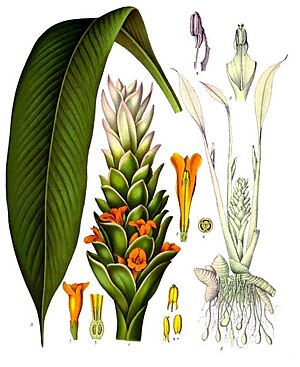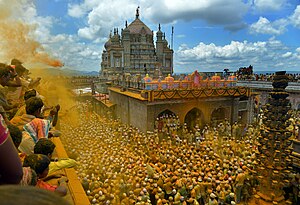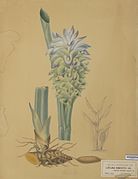Turmeric/ja: Difference between revisions
Created page with "植物化学的成分には、多数のクルクミノイド(クルクミン、デメトキシクルクミン、ビスデメトキシクルクミンなど)を含むジアリルヘプタノイド類がある。クルクミンは、市販のターメリック粉末の検査サンプルにおいて最大3.14%を占める(平均は1.51%)。カレー粉に..." |
Created page with "== 用途{{Anchor|Uses}} ==" |
||
| Line 66: | Line 66: | ||
[[Phytochemistry/ja|植物化学]]的成分には、多数のクルクミノイド([[curcumin/ja|クルクミン]]、[[demethoxycurcumin/ja|デメトキシクルクミン]]、[[bisdemethoxycurcumin/ja|ビスデメトキシクルクミン]]など)を含む[[diarylheptanoid/ja|ジアリルヘプタノイド]]類がある。クルクミンは、市販のターメリック粉末の検査サンプルにおいて最大3.14%を占める(平均は1.51%)。カレー粉にははるかに少ない(平均0.29%)。ターメリックには約34種類の精油が存在し、その中で[[turmerone/ja|ターメロン]]、[[germacrone/ja|ゲルマクロン]]、アトランストン、[[zingiberene/ja|ジンギベレン]]が主要な構成成分である。 | [[Phytochemistry/ja|植物化学]]的成分には、多数のクルクミノイド([[curcumin/ja|クルクミン]]、[[demethoxycurcumin/ja|デメトキシクルクミン]]、[[bisdemethoxycurcumin/ja|ビスデメトキシクルクミン]]など)を含む[[diarylheptanoid/ja|ジアリルヘプタノイド]]類がある。クルクミンは、市販のターメリック粉末の検査サンプルにおいて最大3.14%を占める(平均は1.51%)。カレー粉にははるかに少ない(平均0.29%)。ターメリックには約34種類の精油が存在し、その中で[[turmerone/ja|ターメロン]]、[[germacrone/ja|ゲルマクロン]]、アトランストン、[[zingiberene/ja|ジンギベレン]]が主要な構成成分である。 | ||
< | <span id="Uses"></span> | ||
==Uses== | == 用途{{Anchor|Uses}} == | ||
<div lang="en" dir="ltr" class="mw-content-ltr"> | <div lang="en" dir="ltr" class="mw-content-ltr"> | ||
Revision as of 20:37, 9 June 2025
| Turmeric/ja | |
|---|---|

| |
| Curcuma longaの花序 | |

| |
| ターメリック根茎と粉末 | |
| Scientific classification | |
| Kingdom: | Plantae |
| Clade: | Tracheophytes |
| Clade: | Angiosperms |
| Clade: | Monocots |
| Clade: | Commelinids |
| Order: | Zingiberales |
| Family: | Zingiberaceae |
| Genus: | Curcuma |
| Species: | longa
|
| Binomial name | |
| longa | |
| Synonyms | |
|
Curcuma domestica Valeton | |
ターメリック(/ˈtɜːrmərɪk, ˈtjuː-/、学名:Curcuma longa(/ˈkɜːrkjʊmə ˈlɒŋɡə/))は、ショウガ科ショウガ(Zingiberaceae)科の顕花植物である。インド亜大陸および東南アジア原産の多年生の根茎性草本植物で、生育には20 から[convert: unknown unit]の気温と高い年間降水量を必要とします。毎年根茎を収穫し、一部は翌シーズンの繁殖用、一部は食用または染色用に用いられる。
根茎は生のままでも使用できるが、しばしば水で茹でて乾燥させた後、深みのあるオレンジ色の黄色い常温保存可能なスパイス粉末に粉砕される。これは多くのアジア料理、特にカレー(カレー粉)において、着色および風味付けの目的で一般的に使用されている。ターメリックパウダーは、温かく、苦く、黒胡椒のような風味と、土のような、マスタードのような香りを持つ。
古くからアーユルヴェーダ医学で利用されてきたが、ターメリックまたはターメリックの主要成分であるクルクミンの摂取が病気の治療に効果があるという質の高い臨床的証拠はない。ターメリック植物が生成する鮮やかな黄色の化学物質であるクルクミンは、世界保健機関、欧州議会、およびアメリカ食品医薬品局によって食品添加物として承認されている。ターメリックのサプリメントは、ハーブによる肝障害の増加の原因となっており、政府による規制の対象となっている。

起源と分布
クルクマ属の種数における最大の多様性はインドにあり、約40から45種を数える。タイも同程度の30から40種を有する。熱帯アジアの他の国々にも、クルクマ属の野生種が多数存在する。近年の研究では、C. longaの分類が問題であることが示されており、南インド産の標本のみがC. longaとして識別可能である。世界各地の他の種や栽培品種の系統発生、関係、種内・種間変異、さらには同定についても、依然として確立・検証が必要である。アジアの他の地域で現在「ターメリック」として利用・販売されている様々な種は、複数の物理的に類似した分類群に属することが示されており、現地名も重複している。
歴史
ターメリックはアジアで数世紀にわたり使用されており、アーユルヴェーダ、シッダ医学、伝統的な中国医学、ユナニ医学、そしてオーストロネシア人のアニミズム的儀式の主要な一部である。当初は染料として、その後民間療法におけるそのとされる特性のために使用された。
インドでは、黄色の染料が僧侶や司祭の衣を染めるのに使用されたため、ヒンドゥー教や仏教とともに広まった。
東南アジア島嶼部では、インドとの接触以前、台湾からの拡散(紀元前3000年頃から)後まもなく、オーストロネシア人の間でターメリックが古くから使用されていたことを示す言語学的および状況的証拠がある。インドネシアやフィリピンでは、ターメリックは食品、繊維の染色、医薬品、そして身体の彩色のために使用された。これは様々なアニミズム的儀式において一般的に重要な成分であった。KikusawaとReid(2007)は、オーストロネシア語における「ターメリック」の最も古い再構築された古マレー・ポリネシア語形である*kunijが、主に染料としての使用の重要性に関連していると結論付けている。東南アジア原産のクルクマ属の他のメンバー(Curcuma zedoariaなど)も食品やスパイスとして使用されたが、染料としては使用されなかった。
ターメリック(Curcuma zedoariaとともに)は、オーストロネシア人の拡大に伴い、ラピタ人によってオセアニアにも広まった。ターメリックは根茎でしか繁殖できないため、太平洋諸島への先ヨーロッパ接触以前の分布は、人間による導入のみによって説明できる。ミクロネシア、メラネシア島嶼部、ポリネシア(ハワイやイースター島を含む遠方まで)の住民は、ヨーロッパとの接触以前に、食品と染料の両方にターメリックを広く使用した。ミクロネシアでは、ヤップ島とカロリン諸島のさらに遠い環礁の間で行われた海上交易「sawei」において重要な交易品であった。そこではターメリックは育たなかった。一部の小さな島々では、根茎が砂質の土壌で小さすぎたため、葉から染料が抽出された。また、オーストロネシア人の移住によってマダガスカルにも運ばれた。
ターメリックは、紀元前2600年から2200年の間にさかのぼるファルマーナで発見され、紀元前2千年紀にさかのぼるイスラエルのメギドにある商人の墓でも発見された。紀元前7世紀のアッシュールバニパル図書館にあったアッシリア人の楔形文字医療文書に染料植物として記されている。中世ヨーロッパでは、ターメリックは「インドのサフラン」と呼ばれた。
語源
この名称は、中英語または初期近代英語のturmeryteまたはtarmaretに由来する可能性がある。ラテン語のterra merita(「価値ある土」)が語源かもしれない。ラテン語の種小名longaは「長い」を意味する。
特徴
ターメリックは、高さ約1 m (3 ft 3 in)に達する多年生の草本植物である。非常に枝分かれした、黄色からオレンジ色で円筒形の香りのよい根茎を持つ。
葉は互生で2列に配置される。葉鞘、葉柄、葉身に分かれる。葉鞘からは偽茎が形成される。葉柄は長さ50 to 115 cm (20–45 in)である。単純な葉身は通常長さ76 to 115 cm (30–45 in)で、稀に230 cm (7 ft 7 in)に達する。幅は38 to 45 cm (15 to 17 1⁄2 in)で、長楕円形から楕円形であり、先端に向かって狭くなる。
花序、花、果実
花序の頂部には花のない茎状の苞が存在し、これらは白から緑色で時に赤紫色を帯び、上端は先細りになっている。
両性花は左右対称で3数性である。3つの萼片は長さ0.8 to 1.2 cm (3⁄8 to 1⁄2 in)で、合着しており、白色で綿毛状の毛を持つ。3つの萼歯は不均等である。3つの鮮やかな黄色の花弁は、長さ最大3 cm (1 1⁄4 in)の花冠筒に合着する。3つの花冠裂片は長さ1.0 to 1.5 cm (3⁄8–5⁄8 in)で、三角形をしており、上端は柔らかい棘状である。中央の花冠裂片は両側の2つの裂片よりも大きいが、内側の輪の中央の雄しべのみが稔性である。葯は基部に距を持つ。他のすべての雄しべは仮雄しべに変化している。外側の仮雄しべは唇弁よりも短い。唇弁は黄みがかっており、中央に黄色の帯があり、長さ1.2 to 2.0 cm (1⁄2 to 3⁄4 in)の倒卵形である。3つの心皮は、まばらに毛が生えた癒着性の3裂子房の下にある。果実の蒴果は3つの区画に開裂する。
東アジアでは、開花時期は通常8月である。偽茎の先端には、長さ12 to 20 cm (4 1⁄2 to 8 in)で多くの花を含む花序茎がある。苞は淡い緑色で、鈍い上端を持つ卵形から長楕円形であり、長さは3 to 5 cm (1 to 2 in)である。
-
Curcuma domestica Valeton、1860年頃のA. ベルネッカーによるドローイング
-
デカン高原のターメリック畑
-
ターメリックの花
植物化学


ターメリック粉末は、約60〜70%が炭水化物、6〜13%が水分、6〜8%がタンパク質、5〜10%が脂肪、3〜7%がミネラル、3〜7%が精油、2〜7%が食物繊維、そして1〜6%がクルクミノイドで構成されている。ターメリックの黄金色はこのクルクミンによるものである。
植物化学的成分には、多数のクルクミノイド(クルクミン、デメトキシクルクミン、ビスデメトキシクルクミンなど)を含むジアリルヘプタノイド類がある。クルクミンは、市販のターメリック粉末の検査サンプルにおいて最大3.14%を占める(平均は1.51%)。カレー粉にははるかに少ない(平均0.29%)。ターメリックには約34種類の精油が存在し、その中でターメロン、ゲルマクロン、アトランストン、ジンギベレンが主要な構成成分である。
用途
Culinary
Turmeric is one of the key ingredients in many Asian dishes, imparting a mustard-like, earthy aroma and pungent, slightly bitter flavor to foods. It is used mostly in savory dishes, but also is used in some sweet dishes, such as the Lebanese cake sfouf. In India, turmeric leaf is used to prepare special sweet dishes, patoleo, by layering rice flour and coconut-jaggery mixture on the leaf, then closing and steaming it in a special utensil (chondrõ). Most turmeric is used in the form of rhizome powder to impart a golden yellow color. It is used in many products such as canned beverages, baked products, dairy products, ice cream, yogurt, yellow cakes, orange juice, biscuits, popcorn, cereals and sauces. It is a principal ingredient in curry powders. Although typically used in its dried, powdered form, turmeric also is used fresh, like ginger.
Turmeric is used widely as a spice in South Asian and Middle Eastern cooking. Various Iranian khoresh recipes begin with onions caramelized in oil and turmeric. The Moroccan spice mix ras el hanout typically includes turmeric. In South Africa, turmeric is used to give boiled white rice a golden color, known as geelrys (yellow rice) traditionally served with bobotie. In Vietnamese cuisine, turmeric powder is used to color and enhance the flavors of certain dishes, such as bánh xèo, bánh khọt, and mì Quảng. The staple Cambodian curry paste, kroeung, used in many dishes, including fish amok, typically contains fresh turmeric. In Indonesia, turmeric leaves are used for Minang or Padang curry base of Sumatra, such as rendang, sate padang, and many other varieties. In the Philippines, turmeric is used in the preparation and cooking of kuning, satti, and some variants of adobo. In Thailand, fresh turmeric rhizomes are used widely in many dishes, in particular in the southern Thai cuisine, such as yellow curry and turmeric soup. Turmeric is used in a hot drink called "turmeric latte" or "golden milk" that is made with milk, frequently coconut milk. The turmeric milk drink known as haldī dūdh (haldī [हलदी] means turmeric in Hindi) is a traditional Indian recipe. Sold in the US and UK, the drink known as "golden milk" uses nondairy milk and sweetener, and sometimes black pepper after the traditional recipe (which may also use ghee).
Turmeric is approved for use as a food color, assigned the code E100. The oleoresin is used for oil-containing products.
In combination with annatto (E160b), turmeric has been used to color numerous food products. Turmeric is used to give a yellow color to some prepared mustards, canned chicken broths, and other foods—often as a much cheaper replacement for saffron.
-
Cleaning turmeric rhizomes with boiling water
-
Drying turmeric rhizomes
-
Turmeric powder
-
Cooked vegetables with turmeric as one of its key ingredients, referred to as Sabzi, a dish from India
-
Ganghwang-bap (turmeric rice)
-
Patoleo – sweet rice cakes steamed in turmeric leaves consisting of a filling of coconut and coconut palm sugar prepared in Goan Catholic style
Traditional uses

In 2019, the European Medicines Agency concluded that turmeric herbal teas, or other forms taken by mouth, on the basis of their long-standing traditional use, could be used to relieve mild digestive problems, such as feelings of fullness and flatulence.
Turmeric grows wild in the forests of South and Southeast Asia, where it is collected for use in classical Indian medicine (Siddha or Ayurveda). In Eastern India, the plant is used as one of the nine components of nabapatrika along with young plantain or banana plant, taro leaves, barley (jayanti), wood apple (bilva), pomegranate (darimba), Saraca indica, manaka (Arum), or manakochu, and rice paddy. The Haldi ceremony called gaye holud in Bengal (literally "yellow on the body") is a ceremony observed during wedding celebrations of people of Indian culture all throughout the Indian subcontinent.
In Tamil Nadu and Andhra Pradesh, as a part of the Tamil–Telugu marriage ritual, a dried turmeric tuber tied with a string is used to create a Thali necklace. In western and coastal India, during weddings of the Marathi and Konkani people, Kannada Brahmins, turmeric tubers are tied with strings by the couple to their wrists during a ceremony, Kankana Bandhana. In many Hindu communities, turmeric paste is applied to the bride and groom as part of pre-wedding festivities known as the haldi ceremony.
Turmeric makes a poor fabric dye, as it is not light fast, but is commonly used in Indian clothing, such as saris and Buddhist monks' robes. During the late Edo period (1603–1867), turmeric was used to dilute or substitute more expensive safflower dyestuff in the production of beni itajime shibori. Friedrich Ratzel reported in The History of Mankind during 1896, that in Micronesia, turmeric powder was applied for embellishment of body, clothing, utensils, and ceremonial uses. Native Hawaiians who introduced it to Hawaii (Hawaiian: ʻōlena) make a bright yellow dye out of it.
Indicator

Turmeric paper, also called curcuma paper or in German literature, Curcumapapier, is paper steeped in a tincture of turmeric and allowed to dry. It is used in chemical analysis as an indicator for acidity and alkalinity. The paper is yellow in acidic and neutral solutions and turns brown to reddish-brown in alkaline solutions, with transition between pH of 7.4 and 9.2.
Adulteration
As turmeric and other spices are commonly sold by weight, the potential exists for powders of toxic, cheaper agents with a similar color to be added, such as lead(II,IV) oxide ("red lead"). These additives give turmeric an orange-red color instead of its native gold-yellow, and such conditions led the US Food and Drug Administration (FDA) to issue import alerts from 2013 to 2019 on turmeric originating in India and Bangladesh. Imported into the United States in 2014 were approximately 5.4 million kilograms (12 million pounds) of turmeric, some of which was used for food coloring, traditional medicine, or dietary supplement. Lead detection in turmeric products led to recalls across the United States, Canada, Japan, Korea, and the United Kingdom through 2016.
Lead chromate, a bright yellow chemical compound, was found as an adulterant of turmeric in Bangladesh, where turmeric is used commonly in foods and the contamination levels were up to 500 times higher than the national limit. Researchers identified a chain of sources adulterating the turmeric with lead chromate: from farmers to merchants selling low-grade turmeric roots to "polishers" who added lead chromate for yellow color enhancement, to wholesalers for market distribution, all unaware of the potential consequences of lead toxicity.
Another common adulterant in turmeric, metanil yellow (also known as acid yellow 36), is considered by the British Food Standards Agency as an illegal dye for use in foods.
Medical research
Turmeric and curcumin have been studied in numerous clinical trials for various human diseases and conditions, with no high-quality evidence of any anti-disease effect or health benefit. There is no scientific evidence that curcumin reduces inflammation, 2020年現在[update]. There is weak evidence that turmeric extracts may be beneficial for relieving symptoms of knee osteoarthritis, as well as for reducing pain and muscle damage following physical exercise. There is good evidence that turmeric is an allergen.
Although turmeric is of low bioavailability, some supplements boost potency via a variety of preparation techniques. Turmeric supplements are hepatotoxic and have caused a recorded rise in incidence of herb-induced liver injury. In Italy, the government has banned any claims of turmeric health benefits and mandated warning for turmeric-based supplements.
関連項目
外部リンク
 The dictionary definition of turmeric/ja at Wiktionary
The dictionary definition of turmeric/ja at Wiktionary [[wikibooks:Cookbook:Turmeric/ja |]] at the Wikibooks Cookbook subproject
[[wikibooks:Cookbook:Turmeric/ja |]] at the Wikibooks Cookbook subproject
| この記事は、クリエイティブ・コモンズ・表示・継承ライセンス3.0のもとで公表されたウィキペディアの項目Turmeric(24 May 2025, at 14:58編集記事参照)を翻訳して二次利用しています。 |








